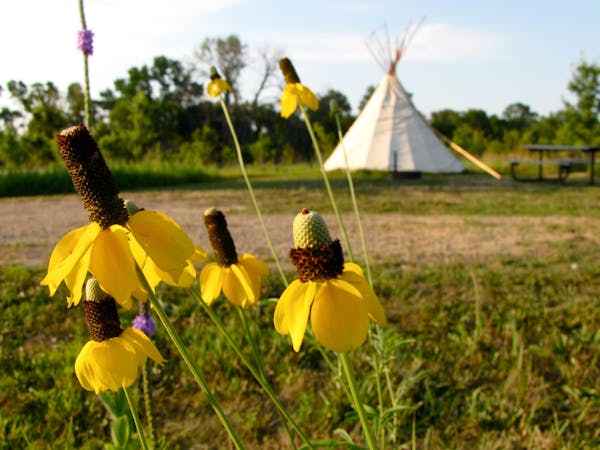Near the entrance to Upper Sioux Agency State Park, turkeys and pheasants peck at the gravel of a quiet road. The road runs under gnarled oak branches and young ash trees, along the Yellow Medicine River to a small row of campsites and picnic tables at the bottom of a hill.
From there, an ankle-wide deer trail leads through knee-high prairie grass and blooming purple leadplants and coneflowers, past prairie clovers and wild raspberries to the top of the ridge. It's the gravesite of Mazomani, a Dakota leader killed by U.S. soldiers while trying to stop a war. Just beyond are the brick ruins of buildings destroyed while people starved during one of the darkest moments of Minnesota history.
The place should have never been made into a state park, said Kevin Jensvold, chair of the Upper Sioux Community. The Minnesota Legislature agreed, passing a law that authorizes closing the park and turning the land over to the Upper Sioux. But the state's efforts to mitigate the effects of closing a state park to right a historical wrong aren't sitting well with others.
Staff with the Minnesota Department of Natural Resources spoke last week to a group of largely skeptical residents in Granite Falls, Minn., about the transfer of the park. The agency is committed to opening a new park or expanding an existing one, or finding other replacements for the park's amenities, DNR Regional Director Scott Roemhildt said.
"I want to make sure that whatever follows the park not only captures the values of the park ... but also stays in this area for the good of the Granite Falls area," he said.
The law signed by Gov. Tim Walz orders the DNR to identify all the federal legal barriers to turn the 1,300-acre state park over to the Upper Sioux Community — a process that could take years. In the meantime, lawmakers gave $5 million to the department, the bulk of which will be spent to replace the park.
Residents doubted that amount would be enough to buy that much land, let alone replace the horse trails and foot paths that wind through the prairie hills and valleys where the Yellow Medicine and Minnesota rivers meet.
"Five-million dollars won't buy a shelter," said Greg Renneke, who lives next to the park. "I understand the Upper Sioux's feelings, but I don't know why we can't both have it."
The park gets about 35,000 visitors a year, fewer than most of the 66 state parks. But that's a significant number for a sparsely visited region of western Minnesota, and it contributes over $1 million a year of economic impact.
"I just hope we can replace that impact," said Kyle Haugen, executive director of the Granite Falls Economic Development Authority. "How do we lure people out here? Finding 1,200 acres may not be what we need to draw people out, but we do need amenities, we need attractions."
The area, along with many other rural parts of the state, has been struggling to keep young people around, said resident Les Bergquist.
"Here we go again — we lost another resource in this community," Bergquist said. "If we don't replace this we'll just have one less reason for people who live here to hang around here."
Jensvold said that the Upper Sioux will be the strongest ally that the city, county and state will have in finding new recreational land.
"I make that commitment to you as our neighbors and fellow Minnesota citizens," Jensvold said. "We want to see opportunities here."
The park was created around the former Upper Sioux Agency, a government-run campus of employee housing, warehouses and a manual labor school. In the early 1860s, the agency was responsible for paying the band of Dakota the money, food and supplies owed to them under the treaties that gave the United States much of what is now Minnesota.
Those payments were rarely made as promised. When supplies were late, the Dakota tried to buy necessities from traders at the agency on credit. They were refused and mocked even as they approached starvation, according to letters kept by the Minnesota Historical Society.
The Dakota attacked, and the war of 1862 began, destroying the agency. All that remains now is an employee duplex, rebuilt and restored decades after the war, alongside the scattered brick ruins of the foundations of the other buildings.
The war largely ended near the Upper Sioux Agency at the Battle of Wood Lake. Mazomani had tried to make peace and protect those who did not join the fight. He was shot by U.S. soldiers while carrying a truce flag trying to negotiate for the release of captives, according to Dakota accounts to the Minnesota Historical Society.
He was carried to a hill, where he died the next morning.
Jensvold, who spent 18 years working to return the land to the community, said that a place where people were starved should not be used for picnics and horseback riding.
The site "has greater meaning than the weekend benefit of the citizens to recreate on," he said.
Jensvold said the tribe doesn't know what it will do with the land yet. That decision will be made by the community's leaders, he said.
"But our position has always been that this is not a place of recreation," he said.
The DNR is open to any ideas for how or where to replace the park.
"That's what we're hoping to hear from the community, what the desires and needs are," said Ann Pierce, DNR parks and trails division director.

GOP endorses Tad Jude for congressional seat Dean Phillips is leaving
One day in the frantic life of a Children's Minnesota emergency room nurse
Sen. Nicole Mitchell off committee assignments while case under review

